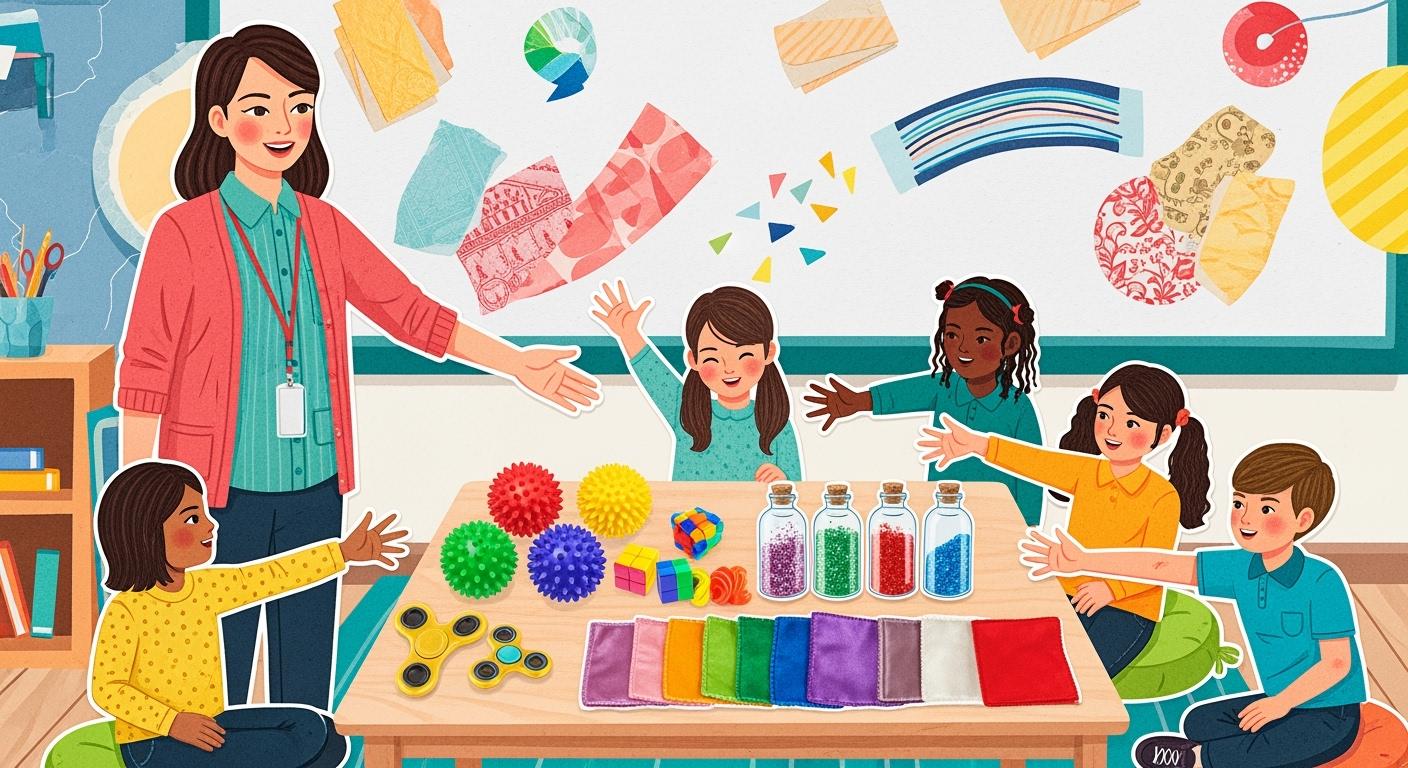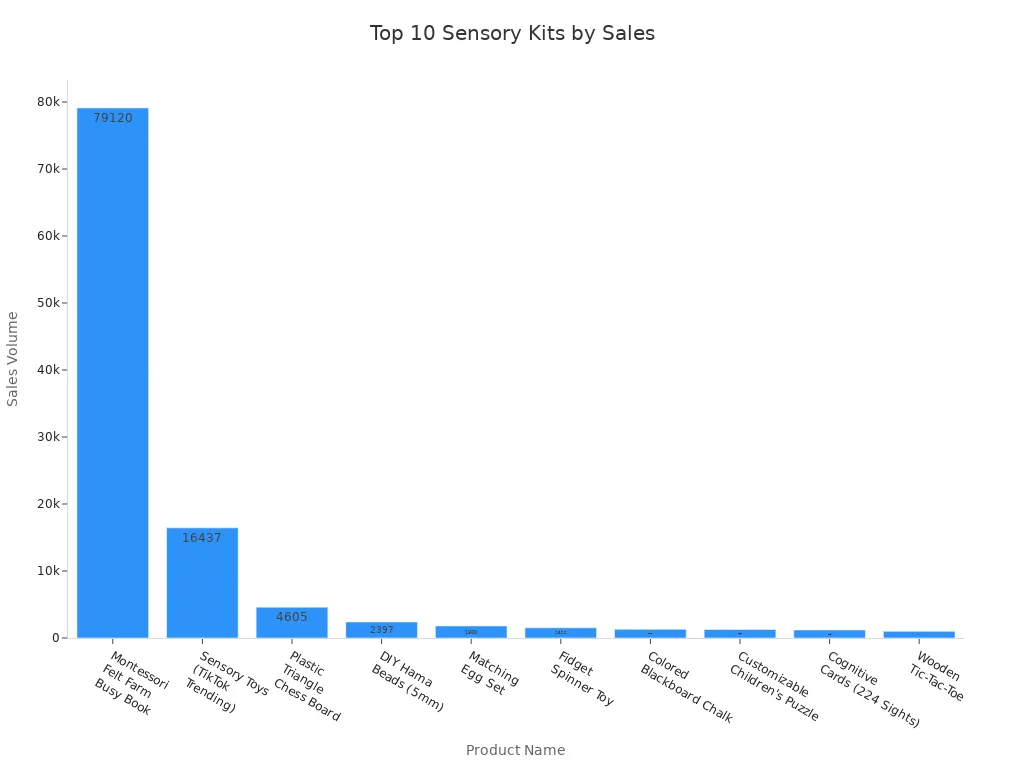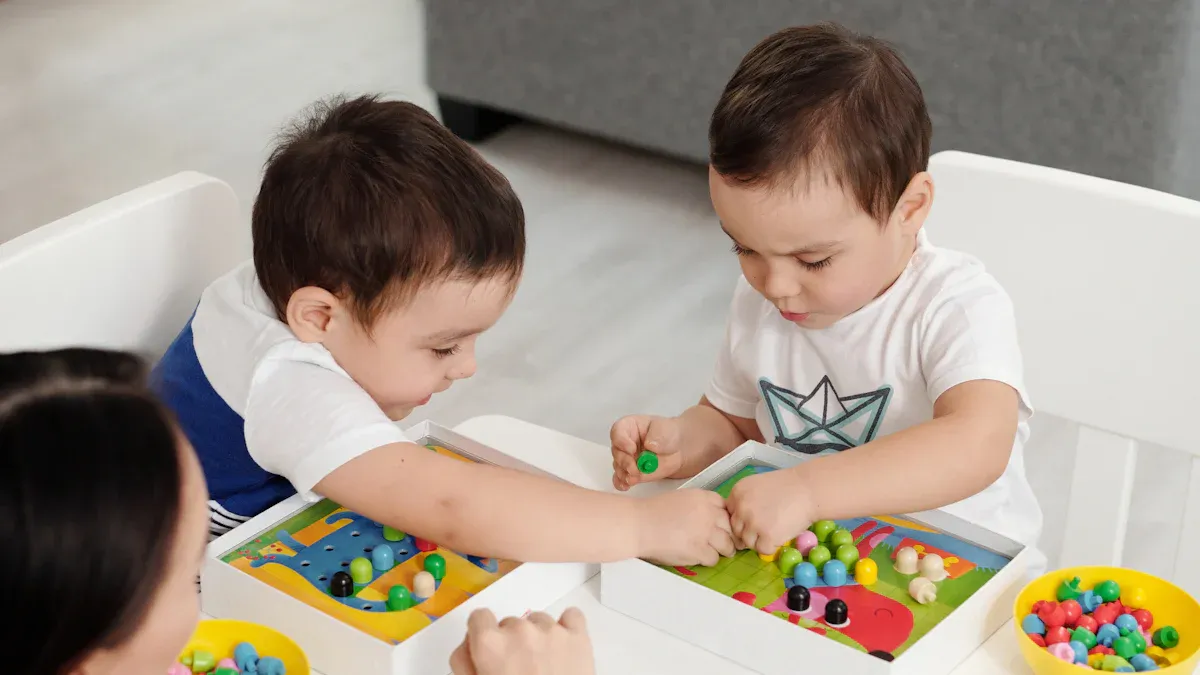Teacher-Tested Classroom Sensory Kits

You want the best sensory kit for your classroom. Teachers like Leemoland, Tried & Tested Sensory Fidget Toy Kit, and Really Good Stuff Sensory Kit. These kits are special because they help kids with Autism, ADHD, and sensory processing challenges. Kids feel calm and can focus better. Sensory rooms and kits help students relax. They build life skills. Students go back to class ready to learn. You see fewer problems and more happy faces. Look at the most popular sensory classroom kits below:
Rank | Product Name | Sales Volume |
|---|---|---|
1 | Montessori Felt Farm Busy Book | 79,120 |
2 | Sensory Toys (TikTok Trending) | 16,437 |
3 | Plastic Triangle Chess Board | 4,605 |
4 | DIY Hama Beads (5mm) | 2,397 |
5 | Matching Egg Set | 1,800 |
6 | Fidget Spinner Toy | 1,522 |
7 | Colored Blackboard Chalk | 1,300 |
8 | Customizable Children's Puzzle | 1,267 |
9 | Cognitive Cards (224 Sights) | 1,194 |
10 | Wooden Tic-Tac-Toe | 1,000 |

Sensory rooms help lower stress and stop overload.
They help students focus and feel balanced.
Students with sensory needs come back ready to learn.
More students come to school and there are fewer problems.
Sensory kits help kids know their needs and learn coping skills.
You can trust these teacher-tested kits to help your classroom.
Key Takeaways
Sensory kits help students with Autism and ADHD pay attention. They also help students feel calm in class. - Pick sensory kits that are safe for everyone. Make sure they are strong and easy to clean every day. - Let students use hands-on sensory activities. These activities help them learn and get along with others. - Make clear rules for using sensory tools. This stops distractions and helps students use them well. - Check your classroom's sensory needs often. Change the tools if needed to help all students.
Classroom Sensory Kit Comparison

Features and Value
You want a classroom sensory kit that works for your students and lasts all year. Let’s look at the top three kits side by side. This table shows what you get, how much you pay, and what makes each kit special.
Kit Name | Key Features | Price Range | Durability & Safety |
|---|---|---|---|
Wide variety of sensory toys, non-toxic, easy to clean, supports Autism and ADHD | $ | Made from durable, safe materials. Easy to maintain. | |
Tried & Tested Sensory Fidget Toy Kit | Fidget spinners, stretchy strings, stress balls, portable bag | $ | Sturdy design. Good for daily use. |
Really Good Stuff Sensory Kit | Tactile balls, textured strips, calming bottles | $$ | Built for classroom use. Safe and strong. |
Safety and durability matter in every classroom. You want kits made from non-toxic materials. Look for designs that handle daily use and are easy to clean. Some brands, like Leemoland, offer ongoing support and warranties, which helps you feel confident about your purchase.
Teacher Ratings
Teachers love sharing what works in their classroom. Here’s how they rate these sensory kits:
Kit Name | Teacher Rating (out of 5) | Most Loved Feature |
|---|---|---|
Leemoland Sensory Kit | 4.8 | Variety and quality of sensory toys |
Tried & Tested Sensory Fidget Toy Kit | 4.5 | Easy to use and portable |
Really Good Stuff Sensory Kit | 4.6 | Calming tools for sensory breaks |
Tip: Ask other teachers about their favorite classroom sensory kit. Real feedback helps you pick the best fit for your classroom.
You can see that each sensory kit brings something special. Leemoland stands out for its wide range and strong build. Tried & Tested is great for quick sensory breaks. Really Good Stuff offers calming tools for group activities. Choose the kit that matches your classroom needs and helps your students thrive.
Sensory Kit Reviews for Classrooms
Leemoland Sensory Kit
You want a sensory kit that meets all your needs. The Leemoland Sensory Kit has many sensory tools for students. It comes with fidget toys, textured balls, stretchy strings, and calming items. Each item feels strong and safe. You can clean them easily, so germs are not a big worry.
Teachers often choose Leemoland because it helps kids get involved and supports sensory growth. Kids like to touch and feel the different shapes and textures. They use problem-solving skills when they play. The kit also helps students think in new ways. Students stay interested and pay attention during group work or sensory tables.
Benefit | Description |
|---|---|
Kids learn by touching and moving the items. | |
Problem-solving skills | Students find new ways to use each tool. |
Critical thinking | Sensory tables make kids ask questions and get creative. |
Sensory development | Using many senses helps kids learn and grow. |
Tip: Put sensory tables in different places in your classroom. You will see students use the sensory tools during breaks or when they need to calm down.
Leemoland Sensory Kit is special because it has many choices and good quality. You can use it for group work, quiet time, or every day. Many teachers say this kit makes their classroom feel friendly and balanced.
Tried & Tested Sensory Fidget Toy Kit
If you want a simple sensory kit, the Tried & Tested Sensory Fidget Toy Kit could work for you. This kit has fidget spinners, stretchy strings, and stress balls. It comes with a bag, so you can move the tools around or take them outside.
Teachers have different opinions about this kit. Some say fidget toys help students with ADHD focus. Others notice some students get distracted if rules are not clear. The kit works best when you match the tools to each student’s needs.
Some teachers think fidget toys help students with ADHD focus.
Other teachers worry fidget toys can distract students, so rules are important.
Fidget toys work differently for each student and classroom.
A study showed kids with ADHD said fidget toys helped them focus.
Teachers need to manage fidget toys for them to work well.
Students need different types of movement, so one kit may not fit all.
You can use the Tried & Tested kit for sensory tables or quick breaks. Just remember to set clear rules. This helps students use the tools in a good way.
Really Good Stuff Sensory Kit
You might want a sensory kit for calming and group work. The Really Good Stuff Sensory Kit has tactile balls, textured strips, and calming bottles. These tools work well for sensory tables or quiet spots in your classroom.
Teachers like that the kit is strong and safe. You can use it for sensory breaks or group lessons. The calming bottles help students relax and focus again. The tactile balls and strips help students handle stress and stay busy.
This kit is helpful if you want a sensory-friendly classroom. The tools work for many ages and needs. You can set up sensory tables for groups or let students use the tools during free time.
Note: Try switching out the sensory tools in your tables. This keeps students interested and helps you see which tools work best.
Each sensory kit has something special. Leemoland gives you many choices and helps with learning. Tried & Tested gives you simple and easy-to-carry tools. Really Good Stuff is great for calming and group sensory tables. Pick the kit that fits your classroom and helps your students do their best.
Choosing Sensory Learning Activities
Assessing Classroom Needs
You want your classroom to feel safe and welcoming. Start by thinking about what your students need most. Look at their age and how they behave. Notice what helps them pay attention. Talk to parents and teachers for more ideas. Sometimes, you need more than one tool to find what works. Here’s a table to help you check important things:
Factor | Description |
|---|---|
Age and Developmental Stage | Match sensory learning activities to your students’ age and growth. |
Reason for Testing | Know why you want sensory activities in your classroom. |
Observations from Parents/Teachers | Listen to feedback from parents and teachers about student needs. |
Practical Considerations | Think about time, space, and training before picking activities. |
Combining Multiple Tools | Use different sensory activities to better understand each student. |
Use this table to help you choose and make your classroom sensory-friendly.
Age Group Considerations
Different ages need different sensory activities. Infants like soft textures and gentle music. Toddlers enjoy water play and easy art projects. Preschoolers love group sensory projects and exploring nature. Here’s a list to help you match activities to ages:
Infants: Soft texture boards, gentle music, safe objects to mouth.
Toddlers: Water play, sensory bins, easy art projects.
Preschoolers: Complex sensory tables, nature exploration, group projects.
Pick sensory activities that help students grow and explore. You want everyone to feel included and excited to try new things.
Budget-Friendly Choices
You don’t have to spend much to make a sensory-friendly classroom. Many sensory activities use simple things like textured balls or stretchy strings. You can make calming corners with soft mats and quiet toys. These spaces help students calm down and take breaks.
Find sensory activities that use many senses and help students regulate. Fidget tools help students with ADHD focus. Weighted lap pads and visual timers help with self-regulation and transitions. Chewelry gives oral sensory input for better regulation. Noise-canceling headphones lower stress and help students relax in busy classrooms.
Mix and match sensory activities to fit your budget and classroom needs. The benefits are better focus, more exploration, and stronger growth for every student. When you pick sensory activities, you help everyone in your classroom learn and grow.
Sensory Play Equipment Tips for Teachers

Daily Integration
You want sensory play equipment to fit your classroom routine. Make calm spaces where students can relax. Set up quiet areas with pillows or soft boxes for less noise. Use weighted lap pads at story time to help students focus. Plan movement breaks during the day. Add sensory strategies to your daily plan. Fill your classroom with noise-reducing headphones and multisensory toys. Give students different seats like wobble stools and beanbag chairs. These changes help students handle sensory overload and feel better.
Tip: Put sensory play equipment where students can reach it. They will use it when they need a break or want to calm down.
Student Engagement
You want students to like sensory play and stay involved. Change lighting and sound to make the room calm. Pick calming colors and textures for your classroom. Let students use hands-on play to explore and interact. Use interactive projectors for storyboards or science games. Make a sensory toy library so every child finds what helps them. Plan movement activities to help students join in and grow emotionally.
Method | Description |
|---|---|
Interactive Projectors | Make sensory storyboards and games for play and learning. |
Sensory Toy Libraries | Give many sensory play tools for focus and exploring. |
Structured Movement Activities | Use movement play to help all students learn and join in. |
Overcoming Challenges
Sometimes sensory play equipment can cause problems. Some students may get distracted or feel overwhelmed. Set clear rules for using sensory play equipment. Teach students when and how to use calming tools. Change out sensory toys to keep play new and fun. Watch for signs of sensory overload and give calming ideas. Talk with students about their needs and feelings. This builds trust and helps students feel safe.
Note: If a student has trouble with sensory play, try new equipment or change your routine. Every child is different, and your help matters.
You can pick from many sensory toolkit choices for your classroom. Leemoland is special because it gives lots of options and good quality. It also supports every student in your class. Sensory toolkit resources help students join in and control their feelings. They also help everyone feel like they belong. You can use these resources for hands-on activities, quiet corners, or calming times. Teachers say these resources make learning more fun and easy to remember. Try out different sensory toolkit resources to see what your class likes. Ask students and parents what they think about the toolkit resources. Share what you learn with other teachers. Your sensory toolkit journey helps all students do well.
Sensory toolkit resources help students join in and build social skills.
Use toolkit resources to make your classroom sensory-friendly.
Get feedback to make your sensory toolkit better.
Your opinion matters! Tell us how sensory toolkit resources help your class.
FAQ
What is sensory play equipment?
Sensory play equipment means tools and toys for exploring senses. These tools let students feel different textures, hear sounds, and move around. You might use things like textured balls, fidget spinners, or calming bottles. These tools help students relax and pay attention. They also help students learn new things in class.
How do I choose the right equipment for my classroom?
Think about what your students need and how old they are. Some tools are better for younger students. Other tools work well for older kids. Try out different tools and see what your students like best. You can use many kinds of equipment together. This helps make your classroom a good place for everyone.
Can sensory equipment help students with Autism or ADHD?
Yes, sensory equipment can help students with Autism and ADHD. These tools help students calm down and pay attention. They also help students join in classroom activities. Weighted lap pads, noise-canceling headphones, and fidget toys are helpful. These tools can really help students who need extra support.
How do I keep sensory equipment clean and safe?
Wash the equipment every day with soap and water or wipes. Keep the equipment in bins or on shelves so students can find it. Check the equipment often to see if anything is broken. Replace broken tools right away. Clean and safe equipment helps everyone feel good in class.
Where should I put sensory equipment in my classroom?
Put the equipment in quiet corners, reading spots, or near group tables. Students can get the tools when they need a break or want to focus. Move the equipment around to see what works best for your class. When students can reach the tools easily, they feel more supported.
Tip: Ask your students where they want the equipment. Their ideas can help you set up your classroom.
Equipment Type | Best Location | Student Benefit |
|---|---|---|
Fidget toys | Desk or table | Focus and calm |
Weighted lap pads | Reading corner | Relaxation |
Noise-canceling headphones | Quiet area | Stress relief |
Textured balls | Sensory table | Exploration |
Calming bottles | Break space | Self-regulation |
See Also
Essential Tools for Educators to Create Sensory Rooms
Easy Strategies for Educators to Design Sensory Classrooms
Ten Engaging Sensory Activities for Preschool Learning
